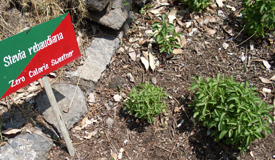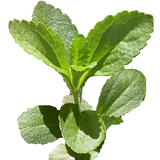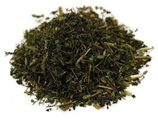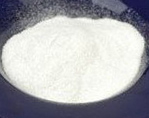
Another great article on Holistic/Homopathic/Natural medicine :
 The good news this product is extremely cheap and can be found at herb stores locally or ordered online from many outlets...Puritans pride as well as Piping Rock
The good news this product is extremely cheap and can be found at herb stores locally or ordered online from many outlets...Puritans pride as well as Piping Rock Stevia plant (herb) nutrition facts
Stevia plant is a small, sweet-leaf herb of South American origin used by native Guarani tribes of Paraguay since centuries. Is stevia safe alternative to common sugar in the carbohydrate-controlled diets? Does it have healthy nutrient profile safe enough for human consumption as in other herbs such as basil, mint, thyme, etc?Recent scientific trials firmly establish that this sweet-leaf herb has, in fact, many health benefiting plant-derived phyto-chemical compounds that help control blood sugar, cholesterol, blood pressure in addition to its use as natural sweetener. Together with the rise in demand for low-calorie food alternatives, stevia has drawn the attention of health conscious fitness lovers all over the planet.
Stevia is a small perennial herb belonging to the Asteraceae family, in the genus Stevia. Its scientific name is Stevia rebaudiana. Some commonly known names are honey leaf plant, sweet chrysanthemum, sweetleaf stevia, sugarleaf...etc.
Stevia plant grows 2-4 feet in height with slender, branched stems, and flourishes well all over temperate, and some parts of tropical regions. It is being cultivated as commercial crop in Japan, China, Thailand, Paraguay, and Brazil. Today, China is the leading exporter of stevia products.
Almost all the parts of the plant tastes sweet; however, the sweet glycosides are typically concentrated in its dark-green serrated leaves. The Guarani Indians of Paraguay have used its leaves to sweeten drinks and foods, and employed in various traditional medicines. In the modern times, it is widely used in foods in many parts India, East Asian region and South American countries.
Health benefits of stevia
-
Stevia herb parts are very low in calories.
Parts by parts, its dry leaves are roughly 40 times more sweeter than
sugar.
This sweet property of sugar in stevia is due to several glycoside
compounds including stevioside,
steviolbioside, rebaudiosides A-E, and dulcoside.
-
Stevioside
is a non-carbohydrate glycoside compound. Hence, it lacks the
properties
that sucrose and other carbohydrates hold. Stevia extracts, like
rebaudioside-A, are found to be 300 times sweeter than sugar. In
contrast to sugar, however, stevia extracts have several unique
properties such as long shelf life, high temperature tolerance,
non-fermentative and at the same time, being near-zero calorie
item.
-
In addition, stevia plant has many sterols and
antioxidant compounds like triterpenes,
flavonoids, and
tannins. Some of flavonoid polyphenolic anti-oxidant
phyto-chemicals present in stevia are kaempferol, quercetin,
chlorogenic acid, caffeic acid, isoquercitrin, isosteviol…etc.
Studies found that kaempferol can reduce risk of pancreatic cancer by
23% (American journal of epidemiology) [1].
-
Chlorgenic
acid reduces enzymatic conversion of glycogen to
glucose in addition to decreasing absorption of glucose in the
gut. Thus, it helps reduce blood sugar levels. Lab studies also
confirm a reduction in blood glucose levels and an increase in the
liver concentrations of glucose-6-phosphate, and of glycogen.
-
Certain glycosides in stevia extract have been
found to dilate blood vessels, increase sodium excretion, and urine
output. In effect, stevia, at slightly higher doses than as sweetener,
can help lower blood pressure.
-
Being a non-carbohydrate sweetener, stevia
would not favor the growth of Streptococcus
mutans bacteria in the mouth which is attributed to be a
causative agent of dental caries and tooth cavities. On the other
hand, certain compounds in stevia rather found to inhibit
caries
causing bacteria in the mouth.
-
In addition, being a herb, stevia contain many
vitals minerals, vitamins that are selectively absent in the artificial
sweeteners.
Stevia plant uses in traditional medicine
-
Stevia extract has been in use by native South
Americans (where it is known as caa-he-éé
or kaa jheéé)
to reduce
weight; to treat wound infections, inflammatory conditions, swelling in
the legs and as a tonic to treat depression.
Selection and storage
In its natural habitat, stevia plant leaves are harvested as and when required. However, most of stevia that made available in the markets is grown under green house conditions or at least in supervised farming. If you grow your own stevia plant in the backyard, pick up leaves with short stem for fresh use. In general, fresh leaves are sun-dried, powdered and stored in an airtight container for future use.
Fresh stevia leaf.
To store, place it in cool, dark, humid free place like the one you do it for other dried herbs such as oregano, where it will stay fresh for several months.
Preparation and serving methods
Farm fresh stevia plant leaves can be used directly in drinks as sweetener. However, most often its dried powder/ refined stevioside/ stevia syrup are being used in the cooking.
Dried stevia leaves. 
Stevia sugar (Rebaudioside-A).
Remember to use dried stevia sugar in small proportions, as it is nearly 30 times sweeter than cane sugar. Roughly, one teaspoonful of dried leaves powder is equivalent to one cup of sugar; therefore, use it in small quantities adjusting the amount to achieve your desired levels of sweetness.
You can also make stevia syrup by adding a cup of hot water to 1/4 cup of fresh, finely crushed leaves.This mixture is allowed to settle down for 24 hours, filtered, and then refrigerated. You may also want to buy stevia sugarrebaudioside-A which is a white, crystalline powder, approximately 300 times sweeter than cane sugar.
Here are some serving tips:
-
In Japan and in many East Asian regions,
stevia plant parts are being used to
sweeten tea, sweets, sauce, confectionary, and soft drinks.
-
Stevia extracts are further refined for use as
table sugar. It can then be added in jam, yoghurt, ice creams,
smoothies, deserts, chewing gum, and sorbets and also to sweeten bitter
medicines.
-
In Brazil, it is used as a remedy to treat
diabetes, high blood pressure, stress conditions…etc.
Safety profile
Stevia plant and its processed products are not being used in the European Union countries for their suspected mutagenic effects. In the USA stevia leaf and its extract is limited to use legally as dietary supplement. However, rebaudioside-A, a processed stevia glycoside, is granted to use safely in many of these countries.
However, in 2006, the World Health Organization (WHO) observed the following statement regarding the use of stevia plant: “stevioside and rebaudioside A are not genotoxic in vitro or in vivo and that the genotoxicity of steviol and some of its oxidative derivatives in vitro is not expressed in vivo.”[2]
In conclusion, stevia and its products are being used in some advanced countries like Japan and for centuries by Guarani tribes of South America and found to be harmless for human use even in pregnancy. (Medical disclaimer).
Truth facts about stevia plant
-
Stevia is the herb plant in the Asteraceae family.
It is being used in some advanced countries as a safe low calorie
alternative, especially in carbohydrate restricted diets.
-
It has been safely used by Guarani tribes of Paraguay
for centuries without
any adverse effects; the fact which is endorsed recently by World
Health Organization.
-
Further, stevia has many natural anti-oxidants
that help lower blood pressure, cholesterol, and control diabetes.
-
Stevia can be safely used in pregnancy and in
infants. (Medical
disclaimer).
Extracting Miracle Crystals from a Leaf...The crystals hide deep inside the leaves of a plant native to South America.
Indigenous tribes have been enjoying the medicinal properties of the leaves for more than 1,500 years.
The active compound found inside the leaf, called “RUBY-A,” attacks the root cause of virtually every non-communicable disease on Earth.
Exactly how powerful are these RUBY-A crystals?
Enough that the FDA gave its blessing to begin adding the crystals to the food supply, immediately.
RUBY-A is a natural, organic replacement for the toxic food additive found in every North American diet. - See another article Goodbye Tobacco, Hello Stevia, Say Tobacco Growers
- http://abcnews.go.com/Business/tobacco-farmers-switching-growing-sweetener-stevia/story?id=20568124

so, which company is making this as a cancer cure??
ReplyDeleteWell Butch...it has been on the market for quite awhile...just now being noticed by the general public...Better Stevia has been a natural sugar subs Manufactured by Now Foods www.nowfoods.com
DeleteThis comment has been removed by the author.
ReplyDeleteStevia has been legal in the US for decades- the limit was in labelling it as a SWEETENER. It used to be listed as an ingredient in herbal teas all the time. I used to buy stevia powder in the supplement aisle at Whole Foods LONG before Stevia came out… and I’m still loyal to the Stevia MyStore brand.
ReplyDelete